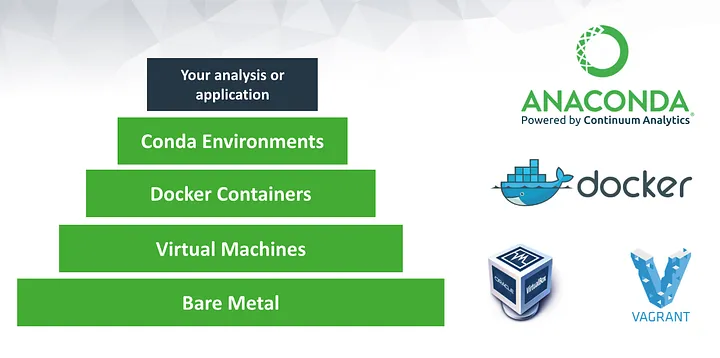Environment
- Effective environment management is crucial for ensuring consistency, reproducibility, and efficiency in software development and data analysis workflows.
- By properly managing dependencies, configurations, and runtime environments, teams can minimize conflicts, reduce errors, and enhance collaboration.
- This is especially important in scientific computing, where reproducibility and stability are key factors.

Common practices for specific tasks include:
- Docker for containerization.
- Singularity for HPC clusters.
- Conda for managing bioinformatics tools.
- Terraform + Ansible for infrastructure.
- GitHub Actions or GitLab CI/CD for automated deployments.
Ensuring a consistent environment across development, staging, and production requires a combination of containerization, infrastructure as code (IaC), and environment management.
For deeper understanding, follow these blogs and documentation:
1. Containerization & Orchestration
It allows the installed softwares can be portable, run on any devices. It commonly uses in production Visual Studio Code provides a cool feature called devcontainers that allows to use the VSCode feature inside container to develop
If a user with docker group that can take the root permissions. Do not add users if they are not the admin. It can be used docker-rootless instead
- Docker – Packages applications and dependencies into containers for consistency.
- Singularity/Apptainer - Singularity/Apptainer is container designed for ease-of-use on shared systems and in high performance computing (HPC) environments
- Podman – Rootless alternative to Docker with improved security.
- Kubernetes (K8s) – Manages and orchestrates containers across environments.
- Docker Compose – Defines multi-container applications, useful for local and staging environments.
✅ Best for: Microservices, scalable applications, and DevOps teams.
2. Environment Management
Good for developing environment. It can be installed via the containers, then, install requires software
- Conda/Micromamba – Ideal for managing Python and bioinformatics dependencies.
- Pyenv – Manages multiple Python versions easily.
- Poetry – Dependency and environment management for Python.
✅ Best for: Python projects, package isolation, and scientific computing.
3. Infrastructure as Code (IaC)
RiverXData uses SLURM to allocate and scale resource. To set up a standard SLURM cluster, please follow this to set up using Ansible
- Ansible – Automates software provisioning and configuration.
- Terraform – Manages infrastructure (servers, networks, cloud services).
- Puppet / Chef – Configuration management tools for infrastructure automation.
✅ Best for: Cloud infrastructure, large-scale deployments, and automating provisioning.
4. Configuration & Secrets Management
- dotenv (.env files) – Manages environment variables for different environments.
- HashiCorp Vault – Securely stores and manages secrets and credentials.
- AWS Parameter Store – Cloud-based secrets management.
✅ Best for: Managing sensitive configuration variables across environments.
5. Versioning & CI/CD Pipelines
- GitHub Actions / GitLab CI/CD – Automates deployment workflows.
- Jenkins – Open-source and highly customizable CI/CD tool.
- ArgoCD – GitOps-based Kubernetes deployment.
- FluxCD – Automates Kubernetes deployments via Git.
✅ Best for: Automating deployment, testing, and ensuring consistency between environments.